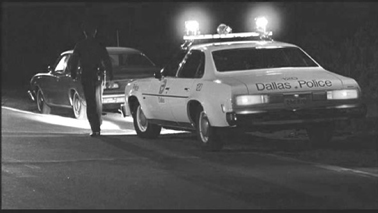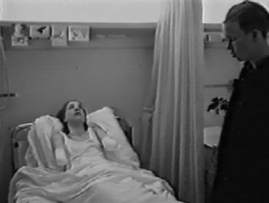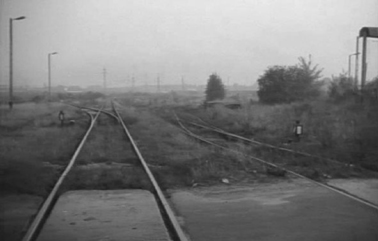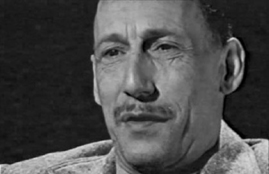
FIGURE 20-1
Different witness versions re-enacted in The Thin Blue Line.
A key aspect of documentary is its ability to provoke discussion. A film does this by posing questions, exposing contradictions, or juxtaposing opposites—all of which challenge audience members to reconcile the contradictions and tensions that have emerged. Conjecture on a larger scale might require reconstructing bygone situations, such as a crucial career interview for a job that your reformed criminal main character has in fact already begun. The company decided to take a chance and hire him, and this has changed his life. The encounter was so pivotal a moment in his life that you decide you must reconstruct it for your film. Your participants are quite willing to re-enact the scene, but can you—should you—film it? To pass the scene off, conjectural as its contents are, as the real thing could be misleading. Will your audience need to know it’s a reconstruction? If so, how do you let them know? You would rightly be accused of faking, and this could seriously damage your credibility—even your career. Some films run a “Scene re-enacted” subtitle, but this seems like overkill if narration or voice-over can imply this with a distancing past tense.
Errol Morris has written about his use of re-enactment to scrutinize witness testimony in The Thin Blue Line (USA, 1988).1 The film shows six different re-enactments of the way a Texas traffic cop died, each illustrating a different witness’s account in the trial (Figure 20-1). The intention is to show just how unreliable witnesses’ memories are, and to prove—as it does conclusively— that not one of their accounts was accurate. In his article, Morris comments on the misuse of re-enactment and archive footage, pointing out that there is, for instance, only one set of shots showing Jews being put on a train to the death camps, yet the same footage is used for any film (including one of my own) about Jewish deportation. Those familiar with a period’s archives find it distressing to see footage repeatedly transposed in time and place to serve a multitude of historical narratives. Today, cropping or altering images is only a mouse-click away, and offers a seductive solution for problems of missing narrative or absent coverage. When done in plain sight to serve the spirit of the truth, this may be no problem. But if the audience is deceived into accepting what it sees as reliable evidence, then it will be treated as deception. The dividing line is one of good faith; there is nothing controversial about showing that a participant got caught shoplifting, if factually this happened. But if he maintains that the store police entrapped him, it matters very much whether we see the actual arrest or a re-enactment.
In Amsterdam in the 1990s some talented film students made an explosive documentary about dropout kids playing a deadly game of laying their arms between the wheels of railroad wagons. As the engine started in the distance, they would wait as long as possible while the clink-clink-clink of the couplings got nearer before jumping clear. The film culminates with a horrific hospital scene in which the smallest boy has lost both arms. Lodewijk Crijns’ Kutzooi (Netherlands, 1995, Figure 20-2) turned out to have been wholly and masterfully fabricated—indeed, not a documentary at all, but a mockumentary. Like those with whom I saw it (mostly documentary teachers), I was irate with the film for bamboozling us, as I think any audience would be.2 We were mugs who had trusted what it seemed to be—recorded actuality. In fact Crijns had been true to his own youth, and to boys’ risky games, but the film was sailing under false colors. The point is that when someone swaps the labels we feel manipulated—indeed, Otto Schuurman showed the film to make this very point. Ironically, we would have praised it to the sky had the makers shown it as a Ken Loach type of fiction film taken, as it truly was, from Dutch working class life.
Some documentaries use actors to recreate biographical material, or even create someone representative but imaginary. Historical biographies routinely use actors when no archive footage exists of their subject, but this is still an acceptable way to explore history if identified as such. Eric Stange, himself a producer of history films, wrote:
Documentary reenactments are almost always shot without dialogue, through fog or haze, or in a shadowy half-light. The camera often focuses only on close-up details—a hand on a quill; feet running through the woods; a sword being buckled on—and almost never on an actor’s face…
These visual clues send several important messages: that the reenactment is not fictional (if it were, there would be dialogue); that the reenactment is only a “suggestion” of what happened (signified by the ambiguous fog or haze); and that the actors are not portraying specific people so much as representing them.
(from “Shooting Back,” Common-Place, April 2001, see www.common-place.org/vol-01/no-03/stange)
Such material can stimulate the audience’s imagination or fill significant gaps in the narrative. It can also, as the article goes on to say, rapidly lapse into money-saving cliché. For plentiful examples, see any episode of the PBS series Secrets of the Dead (USA, 2001–2004). The producers deserve plaudits for tackling riddles of history, but they often repeat their visual material many times, so it is stretched perilously thin.

FIGURE 20-2
The youngest boy loses both arms in the mockumentary Kutzooi.
When reconstruction involves several scenes or even a whole film, the sources on which their veracity rests can be eyewitness memories, documents, transcripts, photographs, or hearsay. British television once showed an acted reconstruction directed by Stuart Hood of the trial of the anarchists Sacco and Vanzetti. Adapted from court transcripts of the famous 1920s trial, it proved intelligent, restrained, and austerely memorable. Because actors portraying the accused, the lawyers, and the judge used only the words and ideas of these people preserved in court records, one could accept it as trustworthy and documentary in spirit. Large-scale reconstruction should carefully identify its sources, or risk alienating its audience.
Usually included with the documentary genre is Peter Watkins’ imaginative reconstruction Culloden (GB, 1964)—a beginning-to-end reproduction of the 1746 battle in the Scottish Highlands. It shows how feudally Bonnie Prince Charlie’s supporters raised their army, and how brutally the British crushed his Jacobite cause. Apart from the costumes, tactics, and location there’s little other pretence of historical accuracy since what the officers and foot soldiers say in Watkins’ “interviews” are a modernist guess at what they might have expressed. The film nevertheless respects the distant historical actuality, and conveys much empathy for its unlucky participants. Yes, it deals with politics and the abuse of power, but its visceral sympathies lie with the humble folk so easily made into cannon fodder by their warlord masters. Those serving recently in Iraq, Afghanistan, Syria, and Egypt will understand its preoccupations intimately.
There is a use of the real that is yet more imaginative—some would say fanciful—called docudrama or dramadoc. This is a hybrid straddling two genres that is seen most commonly, for some reason, in Britain. Two examples from history must suffice, one successful and one not. Jeremy Sandford’s Cathy Come Home (GB, 1966) dramatized the plight of Britain’s homelessness at a time when, sad to think, it was new and shocking. Working from case histories, Sandford and his wife Nell Dunn constructed a “typical” blue-collar couple who overspend, encounter bad luck, and plunge down the social scale until the welfare state dismembers the family “for the good of the children.” Coming on the heels of the Conservative re-election slogan, “You never had it so good,” the British public was appalled to discover that in all its particulars the film was true to life. Its effectiveness lay in superb acting and a documentary presentation, and the furor it aroused caused a change in the law—rare for a film of any kind.
Another docudrama backfired rather badly. Anthony Thomas’ Death of a Princess (GB, 1980) set out to show how a Saudi princess had been publicly humiliated and executed for a sexual offense. Instead it raised a storm of critical reaction on all sides, though less for using actors and reconstruction than for taking factual liberties. The truth was insufficiently determinable, and the portrayal of Islamic culture and assumptions were plainly outside the producers’ realm of sympathy or expertise. Linking the film’s inquiry, and further undercutting its trustworthiness, was a romanticized journalist figure serving as a proxy for Thomas’s own journey of investigation. Undoubtedly he had researched among weird and sinister characters, but transmuting his role to that of a suave, James Bond-ish investigator made the film seem irritatingly self-involved, and implied that the rest of Death of a Princess was similarly contrived. It was docudrama with too much drama and not enough doc.
From Flaherty onward, documentary and reconstruction were inseparable. Today, someone recounting how he had found an unexploded bomb in a ploughed field as a boy might be filmed returning as an elderly man to the very spot where he found it. You might half-bury a bomb casing for him to find, and shoot his actions as he remembers them, laying his voice over the actions. The audience would know from its viewing history that the sequence represents the uncertainties of memory. Alternatively he could tell the camera what he remembers as he relives the actions of finding the bomb. Especially when memory is unclear, and a person must run through several versions in search of the most likely one, there are fertile possibilities for such techniques. Plainly you are not only exploring what happened, but the instability of human memory itself, as Alain Resnais did on a massive scale in his baroque fiction epic, Last Year in Marienbad (France, 1961).
Documentary is an equally good tool for investigating the psychology of memory. Lars Johansson’s Traveler’s Tale (Denmark, 1994,) accomplishes this masterfully: a fictitious old man looks back during the middle of the twenty-first century on film and video he shot just after the walls of Communism had fallen in Central Europe, and outsiders could make their first visits. Its vantage seen from old age sometime in the future, the film is a meditation looking on the socially ossified world that Johansson himself had recently captured while making a similar journey. At the heart of the film is pain at the beauty and illusory nature of experience, and nostalgia for the evanescence of memory. Suggesting this is a mysterious, leitmotif shot (shot repeated to accentuate its symbolic or other meaning) of a partially opened window that frames a field of brilliant yellow flowers (Figure 20-3). This shot, like so much in the film, resists explanation because it is an intuitive rather than expositional narrative. The window opening on the field of flowers somehow suggests the fertile, lost domain of memory and the past.
Occasionally a complete reconstruction is notable for persuading us to accept the authenticity of its central subject. A lovely BBC biographical documentary is Chris Durlacher’s George Orwell: A Life in Pictures (GB, 2003, Figure 20-4). No voice recording or archive footage exists of Orwell, so the producers used the actor Chris Langham to create a facsimile. Looking like Orwell, he speaks words culled from Orwell’s letters, diaries, novels, and essays. Drawing plentifully on period archive footage, the film takes “interviews” with Orwell (played by Langham) and intercuts them with interviews conducted with people who knew him. The effect is eerily authentic, for you go on a major personal retrospective with the great anti-authoritarian author. Mixed in, and not at all intrusive, is a library of 8 mm home movie footage recreated in authentic places—again with Langham and other actors. Strictly speaking, much of its material is fake but the film adds up to a sustained, sympathetic, and imaginative portrait that one feels is trustworthy.

FIGURE 20-3
Lars Johansson’s Traveler’s Tale (Denmark, 1994) explores the psychology of memory, so partial and evanescent.
The authority on docudrama, and tireless champion of its merits, is the distinguished political filmmaker and documentary historian Alan Rosenthal. His Why Docudrama? Fact-Fiction on Film and TV (Southern Illinois Press, 1999) is a comprehensive survey of docudrama’s history and possibilities.

FIGURE 20-4
An actor plays Orwell consummately well in George Orwell: A Life in Pictures.
Mitchell Block’s renowned short film about a female rape victim, No Lies (USA, 1973, Figure 20-5), sets out to show how dangerous documentary becomes in amoral hands. The pressure we see the director apply to the raped woman is disturbing, yet we go along with it because her revelations are luridly fascinating. Then the film turns on its heel to confront us with the fact that both are actors. The exploitative relationship is a calculated performance, one made to,
cinematically…demonstrate and commit rape—and [do] so in such a way as to make the experience of being the unwary, unprepared victim of an aggressive assault on one’s person, on one’s pride, and on one’s expectations of and security in familiar activity in familiar surroundings a very real experience accessible to anyone of either sex who views the film.3
First we voyeuristically enjoy the fruit of exploitation, then the film rubs our noses in our prurience. Gotcha.
Ken Featherstone’s Babakiueria (Australia, 1987) works differently. It reports how Aboriginal colonists discovered Australia back when the country was thinly peopled by primitive whites whose ritual was to cook flesh in places they called barbecue areas (hence the film’s title). When the black colonizers send social workers, a nervously compliant white family tries to cooperate by giving up their children for their own good. By inverting Australian racial values, and farcically reversing white people’s treatment of blacks, the film rams home what it feels like to have liberal paternalism forced on you by another race.
In Larry Charles’ Borat: Cultural Learnings of America for Make Benefit Glorious Nation of Kazakhstan (USA, 2006), the inimitable Sacha Baron Cohen travels around America making people think he is an outrageously crass Kazakh journalist. Made from improvised situations based on a journey framework, this Candid Camera offshoot rejoices in springing practical jokes on the unwary. Borat aims to be murderously funny—and in scenes that defy belief, it truly is. It’s not a documentary, but it borrows documentary methods to capture many spontaneous encounters as they are catalyzed by a highly skilled comedian. If it levels any critique, it is that too many Americans are alarmingly credulous. As a caveat, see Wikipedia for an account of the lawsuits that followed.
If you are working with satire, you must reproduce the form you are lampooning with masterly authority, and your audience will laugh and applaud. If however you mock their trust, then you are attacking the very foundations of audience participation, and will need a compelling reason to do so.
If you are interested in reconstruction, or actively thinking of doing it, try using the DP-9 Reconstruction Worksheet (Table 20-1). It is the kind of provocative questionnaire that one gradually internalizes as one works with a chosen genre (type, family) of film. The multidisciplinary nature of film means one must usually give consideration to a great many facets, which is what makes film such a fascinating and challenging language to use well.
| DP-9 Reconstruction Worksheet |
| Reconstruction: |
|
● What are you really trying to get across to the audience? ● Could you make your point another way and avoid reconstruction? ● What, from the audience’s point of view, makes a reconstruction permissible? ● Are you implying that what you show is typical, or that it is particular and pivotal? (Typical is probably OK, but reconstructing a pivotal moment could backfire.) ● Are you using the original participants, or actors playing them? Will the audience know this? ● What do the participants feel about re-enacting something bygone? ● How should you cover the scene to avoid injecting histrionics? |
| Docudrama: |
|
● What is the film’s premise and why does it need to be a docudrama? ● Why not make a fiction film avowedly based on real events? ● How will you justify “faking it” to the audience? ● What additional values will you put in play to justify taking so much control? |
| Mockumentary: |
|
● Is the target of your satire (if that’s what it is) some practice, custom, event, etc.? Or is it the documentary genre itself? ● If you are lampooning documentary (which can always use some house-cleaning), do you have enough knowledge, ideas, and material? ● How can your piece develop? (Many ideas for this form are one-liners, and not adequate for an extended piece.) ● What is your purpose, if you mean to deceive your audience and then undeceive them? |
1. New York Times (http://morris.blogs.nytimes.com/2008/04/03/play-it-again-sam-re-enactments-part-one).
2. I am indebted to enlightening discussions of docudrama and false documentaries led by Otto Schuurman and Elaine Charnov at the “Sights of the Turn of the Century” documentary conference at the Centro de Capacitación Cinematográfica in Mexico City, 1996.
3. Vivian C. Sobchack, “No Lies: Direct Cinema as Rape,” in Alan Rosenthal, ed., New Challenges for Documentary (University of California Press, 1988), p. 332.